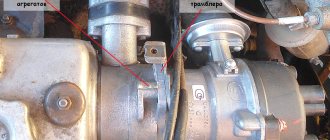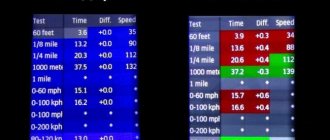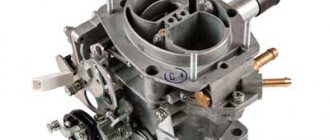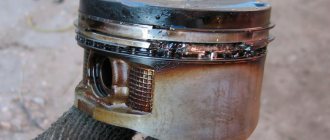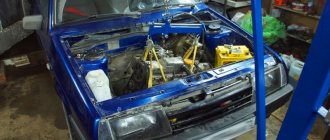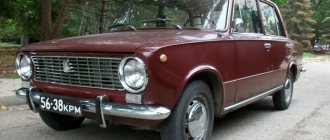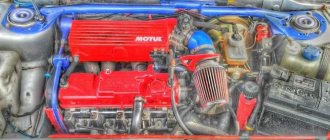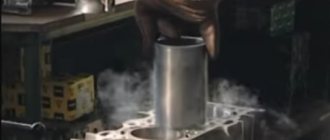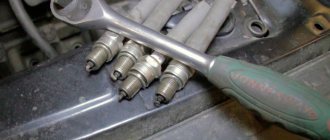A very common procedure for improving the performance of a car is to increase the engine displacement in order to boost it. There are several options for this:
- you can replace the crankshaft by installing another one with a larger stroke;
- bore the cylinder block, thereby increasing their diameter;
- doing both at the same time.
It is more advisable to increase engine volume when block wear requires switching to a repair diameter. In this way, you can kill two birds with one stone - improve the characteristics and carry out repairs.
Crankshaft replacement
The top and bottom dead centers of the piston determine the working volume of the cylinder. If you replace the standard crankshaft with another one, with a larger piston stroke, you will get an increase in volume. The crankshaft for VAZ engines of the 21083 family comes with the piston stroke:
- 60,6;
- 71;
- 74,8;
- 75,6;
- 78;
- 80;
- 84.
The standard piston stroke on the VAZ 21083 engine is 71 mm. The most common way to increase the displacement to 1600 cm3 is to install a crankshaft with a stroke of 74.8 or 75.6. By increasing the piston stroke, it is also necessary to replace or significantly modify the existing ones. Here, too, there are several ways to solve the problem.
You can install pistons with an offset pin hole, or use shorter connecting rods. The most common options include installing special forged pistons under the selected crankshaft, or removing excess metal from existing cylinders. One of the disadvantages is the rapid wear of the connecting rod and piston group. This happens due to the fact that due to an increase in the piston stroke, the operating angles of the connecting rod change, which means that the lateral pressure on the cylinder walls increases.
It is also worth adding that at high speeds, the standard intake and exhaust systems will not be able to cope fully. Filling the cylinders will become difficult, which will inevitably lead to a loss of power. This drawback can easily be attributed to the next method of increasing engine displacement.
Origin of horses: how to boost a naturally aspirated engine correctly
Two words about power
In such a question it is impossible without a pinch of theory, so let me say a few words about the nature of power so that the meaning of any “hardware” modifications is clearer. I dwelled on this issue in detail in one of the previous materials , but here I will only briefly outline the essence.
Power for any internal combustion engine can be expressed as torque times rpm, with a factor. Don’t worry, the output is still the same work per unit of time, it’s just that it’s much more convenient to operate with numbers from the technical characteristics of the machine.
Therefore, it is obvious: to increase power you need to increase torque and speed. Well, or one of these parameters.
In words, the task looks simple. It would seem, what difference does it make, 5 thousand revolutions or 8? In practice, the dependence of the loads on the cylinder-piston group on the speed is quadratic. To put it simply, you cannot recklessly increase the operating speed - the engine will quickly suffer irreversible mechanical damage. Therefore, you need to either “sharpen” the engine at high speeds , or still go by increasing the torque.
In the photo: Koenigsegg Regera, power: 1,100 hp, maximum torque: 1,280 N*m at 4,100 rpm
Articles / Practice What is more important for acceleration – power or torque? This question is one of the main topics of “holivars” on automobile forums. Opponents are ready to tear each other apart, citing dozens of arguments. But everything is simple: power is mome... 370029 6 71 02/02/2015
A little about the nature of torque
It's not that simple with him either. When the torque increases, the load on the piston group no longer increases quadratically, but linearly, but the load increases differently. The crankshaft, connecting rods, piston pins and the cylinder block itself are more heavily loaded.
Okay, let's increase the torque carefully. What needs to be done for this? “Drive” more air into the engine to oxidize more fuel. As you know, to burn one kilogram of gasoline you need 14.7-15 kilograms of air. In terms of liters, this looks much more impressive: 1.4 liters of gasoline versus 12 cubic meters, or 12 thousand liters of air. Therefore, as you understand, it is not so difficult to supply the required amount of gasoline to the engine as to provide it with air.
Therefore, torque will depend on the amount of air supplied to the cylinder per stroke, and power will depend on how much the engine can digest per unit time.
The conclusions suggest themselves: to boost, you need to either increase the working volume or apply supercharging!
Torque and volume
It just so happens that for almost any naturally aspirated engine there is a rule of thumb: 85-100 Newton meters per 1 liter of displacement. A 1.6-liter engine will have 140-160 Nm, a two-liter engine will have 180-200. This is the actual limit.
This rule is quite universal and applies to engines both old and completely new. Powerful and very weak. Unless very old engines deviate from it. Here is the MeMZ-968, an engine from Zaporozhets, its displacement is 1.2 liters, the torque is 80 Nm. But at the same time, the VAZ-2101 is the same 1.2 liters, but already 87 Nm. And these are old carburetor engines with absolutely terrible characteristics of the power supply and ignition system by modern standards!
Articles / History Why modern motors break down more often than old and proven ones In our article about the most reliable motors, modern engines are almost never found. Moreover, among those that are better not to take, the majority are new. Coincidence? Don't think. 228257 14 121 02/23/2015
The modern Skoda Fabia 1.2 engine already produces 112 Nm. Toyota's 1ZZ-FE produces 171 Nm with a 1.8-liter volume, and the much more powerful 2ZZ-GE produces only 180 Nm. The Mercedes M111 2.3 liter produces 220 Nm, and the much newer and more powerful M272 3.0 produces exactly 300 Nm. The extremely boosted Honda K20A 2.0 has a torque of 215 Nm - slightly better than “average”. And so on.
By the way, even 2.4 naturally aspirated formula engines had a torque of around 260 Nm. At a speed of 18 thousand, this was enough to obtain very high power.
The reason for such a small spread in “torque boost” is precisely that it depends on the degree of filling, piston area and piston stroke. The degree of filling is limited by atmospheric pressure and a little more can be squeezed out due to a well-designed intake system. Therefore, it is not only impossible to greatly increase the torque without increasing the displacement, it is simply not necessary.
Turbocharged engines do what they want. Do you want 250 Nm from a 1.4 engine? Please, the 1.4 TSI EA111 engine in the Skoda Octavia can do this. On the Fabia RS the same engine is more powerful, but the torque is the same. And on Mercedes, the M274 2.0 DE20 AL engine can have either 350 Nm or 370. In general, any options are possible. The turbine will inflate as much as the mechanical part of the engine can withstand.
In the photo: M274 engine, power: 245 hp, torque: 370 N*m at 1,300-4,000 rpm
The main conclusion to be drawn is that without supercharging there is no torque. Even the most dramatic changes will only produce small gains. And then mostly at high speeds.
I will talk in detail about boosting turbo engines in the next article. But if you are an opponent of turbines and still decide to “finish” your naturally aspirated engine, let’s move on. What is going on with the engine that from a naturally aspirated 1.6 of some Fiesta they get 180-220 horsepower without any supercharging, and the power of a modest two-liter turbocharged engine exceeds 400 or even 800 horsepower? And what will have to be changed in your completely ordinary engine so that it produces at least 180-200 “horses”? Globally, everything seems to be clear: either “blow” in the name of momentum, or “twist” in the name of revolutions. What will have to be changed in the design to achieve fantastic results?
Hardware work
Even if the engine remains naturally aspirated, there is a lot of hassle. Increasing operating speed is a complex and costly matter. First of all, care is taken to ensure that the piston group can withstand the load at all. The improvements go in two directions: they increase strength and at the same time reduce the weight of the piston group.
We need: forged crankshaft, forged H-shaped connecting rods, low-height T-shaped pistons, extra strong connecting rod bolts. Well, a more efficient oil pump will reduce losses and ensure acceptable strength. In particularly high-performance engines for racing, the piston may be left with only two piston rings to reduce weight, and to reduce friction losses they are made to a minimum thickness.
If your plans are for revolutions over 10 thousand per minute, the connecting rods will have to be made of titanium alloys, although this is not the best material for engine parts. Despite their high strength, its alloys are too ductile, and in internal combustion engines the manufacturing accuracy goes to microns. A very high load falls on the lower head of the connecting rod, and therefore the requirements for their studs or bolts are very high, and tuning parts are extremely expensive for this very reason.
Articles / Practice Extra horses: dangerous and pointless chip tuning of naturally aspirated engines Many car enthusiasts have heard about a wonderful way to increase engine power. All you need to do is change the control program - and immediately the machine will gain a lot of power and start “bulleting” like... 107404 21 34 03/16/2016
Of course, the changes are not limited to the new piston group. The requirements for the timing mechanism are also growing. As the speed increases, the elasticity of the valve springs must increase so that they have time to return the plates to the closed position. Here it is necessary to reduce the mass of the valves, and at the same time their heat transfer capabilities. In addition, with more aggressive camshafts, the speed of valve opening and closing increases, and the load on all components of the mechanism increases. In general, valves are usually replaced with lightweight and especially durable ones. Titanium parts are occasionally used here, but more often high-strength steel and cermets are used.
Well, the next question is to adjust the resonance phenomena at the intake and exhaust of the engine using the intake manifold, exhaust and camshafts. Of course, they expand the “bottlenecks” in the form of a throttle, or even switch to a multi-throttle intake, with a separate valve for each cylinder.
If you act wisely, the shape of the channels in the cylinder head and other places in the intake tract usually also requires optimization. To do this, the engine is “blowed out” and pressure loss points are looked for - places with increased resistance to air flow. In practice, the processes of modifying the intake are no simpler than modifying the piston group of the engine, and with “light” tuning they completely eat up the bulk of the modification budget.
Here, for example, is the Opel C20XE engine. The engine was modified by Lotus specialists and is a typical example of a “homologation engine” - an engine that was initially prepared for modifications by the manufacturer itself. It’s not for nothing that it was used in the WTCC by the Opel team, and then Chevrolet and Lada for a good fifteen years. Its design can withstand forcing quite well, and therefore the list of necessary changes looks quite modest.
With an initially less “durable” engine, the budget would be higher, and many times higher. The stock C20XE has a displacement of 2.0 liters and a power of 150 hp. With. English companies have gained a lot of experience in preparing this engine for various races and there are so-called “whales” that you can buy and install on your engine. Of course, the engine must be perfectly assembled and not have significant wear. For example, let's use the products of the Qedmotorsport company.
Each modification kit includes an intake manifold with individual throttles for each 45 mm diameter cylinder, a new fuel pressure regulator, a fuel rail, a new engine control system (ECU), a two-stage maximum rev limiter and comes complete with a wiring kit. The system is homologated for use in motorsports.
The minimum level of modifications guarantees a power of 190-200 hp. With. when installing camshafts with high cam heights and stronger connecting rod bolts. The price of such a kit is 1,800 pounds. Not on a budget, but everything was calculated not in a garage, but by professionals.
Want more? Set of modifications C20XE up to 210 hp. With. includes replacement pistons for operation at higher speeds, split timing gears for fine-tuning timing and even more “aggressive” camshafts. The price of such a kit is already 2,300 pounds.
To get another 10 hp. on top, with a power limit of 215-220 hp, the kit receives new camshafts designed to operate without hydraulic compensators, new pushers, new valve springs. The price of such a kit is already 2,550 pounds.
The top kit, with a maximum output of up to 245 hp, includes the same kit as the previous one, but tuned for higher speeds and loads. Price: £2,750. The finished engine with a stand certificate for 240-260 hp. has a price of about 3,500-5,000 pounds, depending on the manufacturer.
The maximum power level that factory racing teams had with such an engine was about 280-320 horsepower with an unlimited budget.
Another example is the 2.0 Duratec engine, which is very popular in the Fiesta and Focus rally cars. The same 2 liters and 150 hp, but a more modern design. For example, let's take the English modifications of Omex Technology Systems.
Motor with a set of modifications up to a power of 180 hp. costs £5,995 excluding sales tax. The kit includes a new intake manifold with custom intake piping and throttle bodies, control system, evil camshafts, heavy-duty connecting rod bolts and exhaust system. Maximum revolutions are 7,800 per minute, maximum power is achieved at 6,500.
Motor with a set of modifications up to 200 hp. With. includes modifications to the cylinder head and combustion chambers. The price of such a motor is 6,895 pounds excluding taxes. Maximum power is achieved at 7,000 rpm.
The maximum level of modification up to a power of 260 horsepower includes forged pistons for the highest loads, H-shaped forged connecting rods, more elastic valve springs and a timing relief kit, more efficient injectors and other modifications. Maximum rpm 8,700, maximum power at 8,500 rpm. The price of such an engine is already 11,595 pounds.
In general, as you can see, correct “atmospheric tuning” is quite expensive, difficult, and the output is not exactly stunning.
Effect
Even with a small increase in maximum speed, you can significantly increase power if you reduce the torque drop or even slightly increase it at maximum rotation speed.
While maintaining the amount of torque by transferring it to the higher speed zone, you can get an increase in power by 30-40%. In fact, it is the restructuring of the intake that is the key to high power of an atmospheric engine, and the limitation here is the capabilities of the piston group.
Design limit
The higher the degree of boost of the naturally aspirated engine, the more effort needs to be applied. Revs up to 7 thousand do not require much effort if the maximum of the stock engine was at 6 thousand.
Every thousand revolutions in excess comes at a high price. All elements must become lighter and stronger, and this is not just difficult, but very difficult to combine. Already 10 thousand revolutions for a standard piston group of a typical “square” engine is an unattainable dream. Most highly boosted engines are limited to 8,500-9,000 rpm. Particularly short stroke designs may attempt to achieve higher RPMs. For example, small motorcycle engines feel quite good at speeds above 13 thousand, but it is unrealistic to boost a “civilian” car engine to such an extent.
All tricks are useless; losses in the piston group increase too quickly. And even serious modifications to the timing mechanism to increase efficiency will no longer help, although there is still a way to go for motorcycle and racing short-stroke ones. Let's say there is such a thing as a desmodromic valve mechanism, where springs are not used - they withstand extremely high speeds. But this is expensive and unjustified - now such a mechanism is used only on Ducati motorcycles, and mainly for the sake of image. And on formula machines they used “pneumatic springs” of the valves, allowing them to “play” with elasticity over a wide range.
In a word, I will repeat once again what has already been said above. It is impossible to seriously increase engine power without using one or another boost. I will talk about “supercharged tuning” in the second part of the story about boosting.
Survey
Have you ever tried to boost a naturally aspirated engine?
Your voice
Total votes:
Cylinder block boring
This option involves expanding the diameter of the cylinders and installing pistons of larger diameter, which in turn also increases the working volume. Any major overhaul, a kind of small tuning, in the direction of increasing volume. With the right approach, and hands growing from the right place, they can be bored up to 84 mm. Further boring is dangerous, casting defects may appear, and then you can go for a new block. But there are also limitations and disadvantages here.
A significant reduction in the thickness of the cylinder walls will, in any case, lead to a small but reduced service life of the cylinder block. The thermal load also increases; in other words, thin walls will heat up much faster.
Boring the block and replacing the crankshaft
This option includes both of the above, and allows for a maximum increase in engine displacement. For example, boring to a diameter of 84 mm, with the installation of a crankshaft with a stroke of 80 mm, will increase the engine capacity to 1798 cm3. In this case, you will also need to install forged pistons.
Whatever option you choose for yourself, it is important to remember that engine modification is a very serious and painstaking matter. It is best to entrust the matter to professionals who have done their best in this matter.
After all, without the necessary skills and special equipment, tuning risks turning into flour and a waste of money, time and effort. Only after carefully weighing all the pros and cons is it worth going to the store for spare parts. As a rule, the costs of boosting an engine, including the cost of spare parts and labor, do not bring any tangible benefit to the owner. You are unlikely to feel an increase in power, as they say in the seat, your nine will not press you anyway.
What else is worth reading
Engine overhaul
Rear gearbox, device and principle of operation
Engine troubles when cold
Is it possible to install xenon
Traction control system TCS
Tuning the intake system
Improving the intake is a reduction in the resistance of the incoming air into the cylinders. This is not a very complicated modification, but it requires changing or adding a large number of details, which together will give a good result.
Nulevik
The first thing you need to do is install a zero-resistance filter, which will greatly reduce air resistance, since the standard filter has a filter element made of very dense material, and the design of the filter itself does not allow a large amount of air to enter. Just above the link you can read more about Nulevik, how to install it and what results you can get from it. I would like to say right away that by installing only the zero gear, the engine power will not increase significantly, so it should be installed only with comprehensive engine tuning.
A throttle valve of increased diameter is also a necessary replacement for complex tuning. You won’t get much results from this part, but for complex modifications this part is simply necessary, as it reduces the speed of incoming air, thereby increasing the performance of the intake system. You can also find out more about this improvement using the link above.
Installing or replacing the receiver
For better engine power, the receiver has a large volume and short intake pipes. Installing this part gives a good result and therefore it can be installed even with minor modifications to the engine. This part smoothes out air pulsations. Due to the fact that the intake pipes are short, the maximum filling of the cylinders shifts to higher speeds, thereby horses and torque become greater only at high speeds, and decrease slightly at low speeds. You can ensure that only the torque at low speeds increases, but at the same time the engine thrust throughout the entire range will become less.
You can also install an intake system in which the geometry of the channels changes so that the cylinders are filled with air ideally throughout the entire range, based on data on revolutions and throttle opening. This will be the most ideal, but at the same time expensive option.
No intake manifold
Sometimes the intake manifold is removed, and instead of it, so-called pipes are installed, which are tuned to high speeds. This allows you to greatly increase the amount of air entering the engine, also reduces idle speed and improves stability at low and medium speeds. At high speeds, of course, everything becomes simply gorgeous.
This is the most difficult thing in tuning the intake of naturally aspirated engines, but at the same time it is the most effective and expensive option. You can also install multiple throttle valves, thereby improving the response to the gas pedal. Unfortunately, as a result, the service life of your engine is reduced and fuel consumption increases quite significantly.

